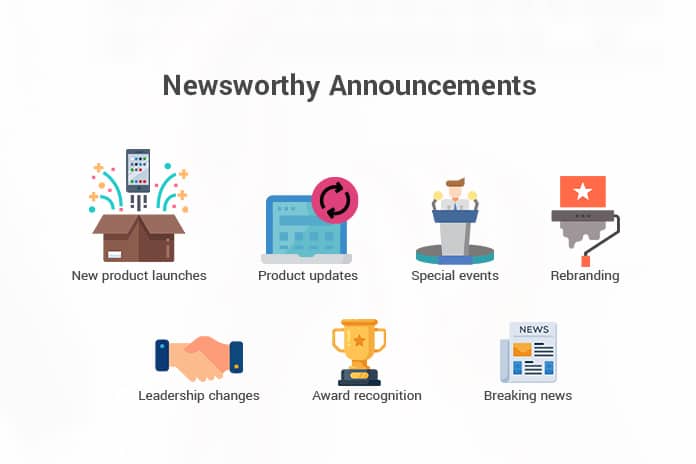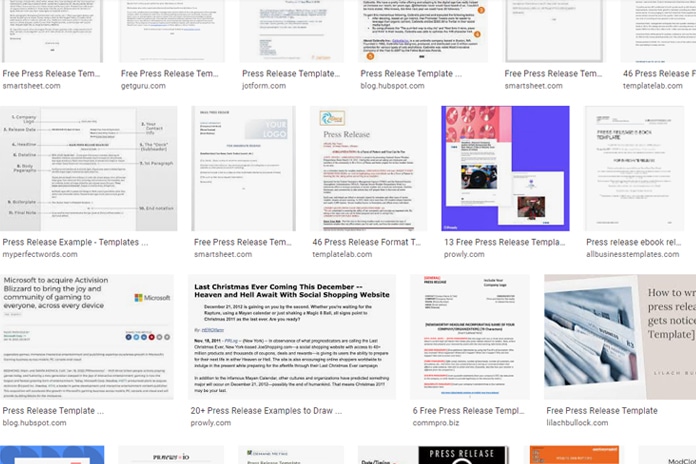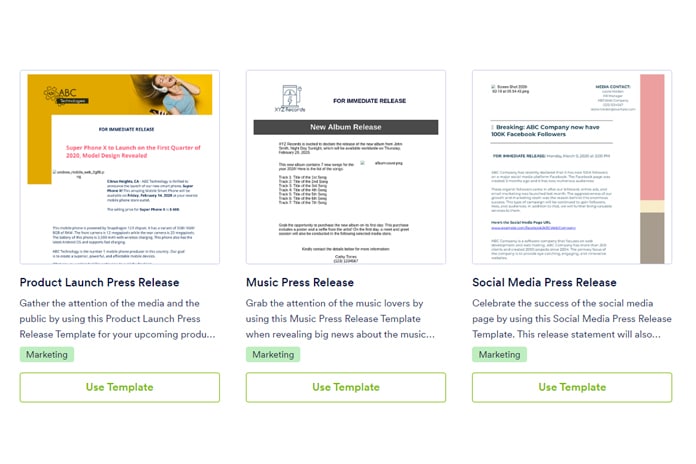Press releases are an essential part of business. They're a way for your company to write something extremely self-promotional without all of the usual issues of self-promotion in writing. They're a great way to reach out to the press and get a lot of coverage in a very short amount of time.
The idea of a press release has, unfortunately, been watered down over the years. It's harder than ever before to get real attention from a press release, instead of just uploading it to directory sites that only have traffic from other people there to upload their own press releases.
A press release should be the first step toward making your product known to the public. When news outlets see that you’ve announced something new, they’ll be more inclined to pay attention and write about it later. However, writing press releases can seem challenging, especially if you’re not experienced with journalism. With the proper guidelines and examples to follow, you can create a press release that will catch journalists’ eyes and make them want to cover your story.
 If you follow the guidelines and write a top-tier press release (or hire a freelance writer to write one for you), you can use it to reach out to the press in your industry, area, or the internet in general, and pull in traffic and attention.
If you follow the guidelines and write a top-tier press release (or hire a freelance writer to write one for you), you can use it to reach out to the press in your industry, area, or the internet in general, and pull in traffic and attention.The question is, how?
Writing a good press release means following the guidelines. Remember, a press release is not a landing page, it's not a blog post, it's not an eBook, it's not a script, it's a press release.

It has to serve a specific kind of purpose for a specific kind of person.
 Understand the purpose of a press release.
Understand the purpose of a press release.
First, you need to understand the purpose of the press release. To quote CoSchedule:
"A press release is a formal announcement made by a company that contains the most pivotal information about its latest business development."
A press release is a short document you give to journalists and members of the press, specifically. It's meant to be short, to the point, and extremely focused. Journalists don't have a lot of time or energy to waste, after all. So, your press release is packed with relevant details and virtually nothing else.
 Only use a press release for newsworthy purposes.
Only use a press release for newsworthy purposes.
Press releases get mixed up with blog posts and more-or-less meaningless announcements all the time. This is unfortunate because it means journalists are more inclined to ignore them, they don't get as much traction, and they're often written incorrectly.
A good press release is only used when it's a newsworthy announcement. "Our CEO was interviewed" isn't newsworthy, nor is "we published a new blog post about some topic or another."

So, what kinds of topics and purposes are valid for a press release?
Anything not on this list is probably not worth writing a press release over. That might not be 100% true, but you need a good reason why the press should cover what you're looking to announce. Remember, if you wouldn't care about it if you saw it in your local newspaper, the press won't either, and a press release isn't worth writing.
 Be careful with templates.
Be careful with templates.
Templates are very useful for press releases if you use them right. If you use them wrong, however, it's easy to let your release get lost in the shuffle.
A press release template will give you formatting for the page, including things like where to place your release line, where and what contact information to include, and what order to put salient points. This is what you should copy from a template.

What you shouldn't copy from a template is specific phrasing, just with keywords swapped out. You don't want your "news" to come across as "just another release" because then you won't have any interest from journalists or readers.
Otherwise, use templates as a way to inspire your rhetoric, but not as a way to copy someone else's.
When it's time to actually write a press release, you (or your freelance writer) need to know how to do it right. Here's how.
In blogging, headlines are extremely important. In press releases, headlines are make-or-break. A good headline is the difference between coverage on Forbes or being completely ignored. Here's an excellent guide on writing press release headlines specifically.
A good press release has a good angle. The news itself is news, of course, but you want it to have some driving "why should I care, though?" angle to it. For example, does it encourage a particular emotional response? Does it announce significant progress made towards solving a major problem, either with your product, your company, your industry, or the world? Does it relate to an ongoing conflict, on one side or the other? Does it have a specific or outsized impact on a particular community? These are all good angles.
Your press release cannot have a buried lede. You need the most important information, the conclusion or takeaway, in the first paragraph or even the first sentence. After that, you include important details and salient information.

After that, you can include other details, information about who you are, your boilerplate copy, and ways for a reader to learn more. Anything else is nonessential and should be left out of the release itself.
Your press release should contain everything a journalist needs to pursue a story at a basic level. However, if they want to dig deeper, it should give them avenues to do so. A link to a press kit, a link to a longer release on your site, a link to further reading, these are all great. You should also have contact information, like a phone number and email address, for journalists to follow up and ask specific questions if they have them. Make sure it's a well-monitored line and not just your customer service line; if you put a journalist on hold, they're likely going to hang up.
Press releases have a standard format. They have a line that says "For immediate release" or "For release on X date," depending. Put in your killer headline and a subheading for additional attractiveness following the release date. Then start with a dateline for when you're submitting the release, so journalists can immediately see if it's old news. Use AP style and appropriate spacing between lines and paragraphs. And, of course, wrap up with a boilerplate for your company, with name, mission statement, founding dates, company size, and other salient information, as necessary.
Also, every press release typically ends with a centered set of hashtags (###) to indicate the end of the release. This is especially critical if your release goes onto two pages, but if you can keep it to a single page, you should.
You can see this in virtually all of the templates you'll find later on in this post.
Now let's get into a few choice tips that can help take your press release from just another piece of paper on the pile to something worth the attention of industry-leading journalists.
First, include a pull quote from your CEO or representative leadership. This quote should be a compelling statement that the journalist can use verbatim to showcase the heart of the issue.
Another great tip is to make sure you have at least one, and up to three, calls to action in your press release. These CTAs should be tangible steps that any reader, from the journalist to someone reading the release later, can take to understand or learn more about the topic. Remember, these aren't usually sales-focused, they'll be "learn more" links or newsletter waiting lists.
Use high-impact, high-value keywords to showcase the importance of your press release. If you won an award, make sure to specify it's an Industry-Leading award. If you've been consistent, specify that it's the tenth consecutive quarter you've won it. If you're replacing your CEO with a new one, note that the new one is a high-performer who takes companies to the next level. Superlatives are great here as well.

If you have to announce sad or negative news, don't beat around the bush or try to soften the blow. Be up-front with the facts and the news, convey a clear explanation, and offer the next steps interested readers can take. You don't need to play up the drama or try to make it easier to hear; it won't work anyway.
Write a lot of different headlines. It's very rare that your first impulse is the best for a headline. You can, instead, focus on trying out different headlines, keywords, and ways of conveying impact. Consider using a headline analyzer or generator to get ideas and look at existing press releases to see what else is being done.
When you're hiring freelancers, make sure they're knowledgeable or trained in press releases. General blog writers and other writers may not be capable of the compelling, high-intensity style necessary to convey a great press release. If possible, ask to see a sample of a release they've written before, to make sure. There's no shame in hiring a writer specifically for press releases, even if you have a great blog writer already. The skill sets are different, just like marketing and sales are different.
There are tons of press releases on the market that you can use for inspiration. There are also a ton of press release directories where you can see some of the most recently-written and published press releases. Feel free to check those out. Otherwise, here are some excellent press releases you can view as examples.
This page on CoSchedule has 16 more examples. You can also see examples of press releases from this HubSpot post. Other possible examples include:
Between these, you should get an excellent idea of how a press release should look and what kind of conventions exist (and when you can break them for dramatic effect).

There are also plenty of templates available.
A press release isn't something you send out just for fun—it's a marketing tool that can get your company news coverage and drive sales. It should be viewed as an extension of your overall marketing strategy, aiming to land you coverage in major media outlets. It's also a way for reporters and bloggers covering your industry (mainly if it's niche) to learn about your product or service and its benefits.
There's more than enough here to sate the need for any business, for any kind of announcement. Whatever your needs, something here will give you the inspiration you need.
If you need help writing an expert press release, we're here to help. Check out our job board, and you're sure to find someone to meet your needs. Additionally, if you have any questions, either about today's topic or just freelance writing in general, be sure to leave a comment down below! We'd be more than happy to assist you however we possibly can!
We encourage you to share this article on Twitter and Facebook. Just click those two links - you'll see why.
It's important to share the news to spread the truth. Most people won't.